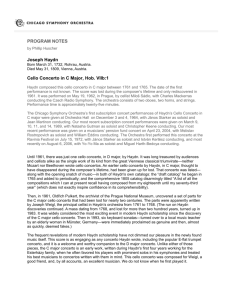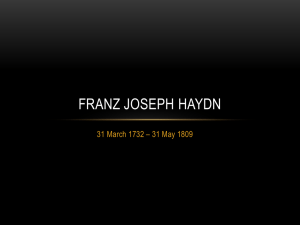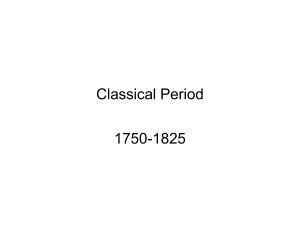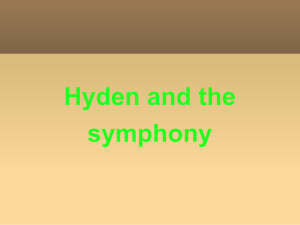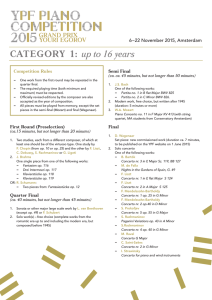Research into practice: a model for sustainable writing development
advertisement
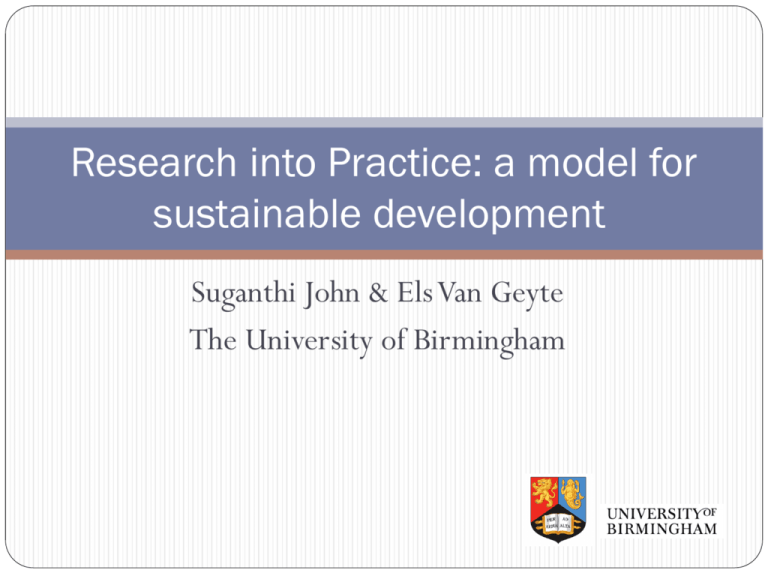
Research into Practice: a model for sustainable development Suganthi John & Els Van Geyte The University of Birmingham Purpose To share our experience of how we brought research and practice together on a project to redevelop thesis writing materials for international students. Outline Two sections to our paper: The background, aims and description of our project Looking at some examples from our project of how we brought research and practice together Background The needs of current students & their research areas Increased numbers and larger number of research areas Interdisciplinary nature of research Empirical vs non-empirical research writing Our task To redevelop our materials to cover a wider range of disciplines To ensure that both empirical and non-empirical research types were covered in our course What research we did: Looking at e-theses in a number of fields in the humanities and social sciences Books on academic writing Hamp-Lyons & Heasley (2006) Paltridge and Starfield (2007) Swales & Feak (2008) Bitchener (2010) Research on academic discourse and the teaching of academic writing Flowerdew (2002) Hyland (2009) Journal articles Research into Practice: a model for sustainable writing. Practical examples empirical Introduction Literature review Methodology Results Discussion Conclusion non-empirical sections less distinguishable Reasoning for adding a task: signposting for course awareness of types of research reflection: type of thesis / suitable organisation Research: http://etheses.bham.ac.uk/ Abstracts NER examples on hand-out 1.Social Sciences/ Centre for Russian and East European Studies 2.Arts and Law/ Music New task Recognising empirical and non-empirical research The table below provides you with examples of empirical (ER) and non-empirical research (NER). Can you identify which is which? See hand-out for example: Author and Title Content 1. Focusing on the reform trajectory in the fields of judiciary reforms, anti-corruption and external border policies between 1989 and 2007, this study assesses the interaction between EU politics and domestic politics and the role of domestic factors in slowing down internal reforms. Scarpitta, Lara (2009) ‘ Justice and home affairs and Romania’s accession to the European Union’ (PhD) 2. Furse, Edward Niel (2010) ‘Perspectives on the reception of Haydn’s Cello Concerto in C, with particular reference to musicological writings in English on Haydn’s Concertos and the classical Concerto.’ (Master of Music) This thesis illustrates the extraordinary quality of Haydn’s Cello Concerto in C, Hob. VIIb: 1, and addresses the musicological literature in English that relates to it. Chapter 1 introduces the concerto. Chapter 2 illustrates the scarcity of literature in English pertaining to Haydn’s concertos. Chapter 3 widens its scope to include literature on the Classical concerto. Haydn’s Cello Concerto in C is presented as an aesthetic alternative to Mozart’s later and more complex works. This chapter also touches upon the Classical-concerto literature’s unhelpful emphasis upon first movements. Methods Section Before: Auditory comprehension of English by monolingual and bilingual preschool children Method 1…2… Task: Why do you think the author chose to order the elements in this way? Issues: Education/ English Task does not engage students enough Task is not interactive enough Research: Sociology Journal: http://www.socresonline.org.uk/15/1/1.html Methods Section After: Parenting in Post-Divorce Estonian Families: A Qualitative Study Task 1 The following sections are not in the order that they appeared in the methods section in an article from a sociology journal. Can you order them? Results Section Before: Explanation: Reporting/Stating results [Move 2] Thirdly, but as an adversative conjunction was also used in the Japanese students’ texts. The frequency of the adversative conjunctions ‘but’ was 33.08%. Commenting on the results/generalising/conclusions [Move 4] As mentioned above, the frequency of additive conjunctions was 27.76%, therefore, the frequency of adversative conjunctions in the texts is almost equivalent to that of the additive conjunction. Issues: Education Another ER example ‘move’: technical term Research: ER example replaced with NER (Arts/English) http://etheses.nottingham.ac.uk/568/1/Thesis_EF.pdf ‘moves’ and ‘steps’ replaced with ‘stages’ and ‘steps’ Swales, J., and Feak, B., AcademicWriting for Graduate Students, University of Michigan Press, 2004 Results Section After: Explanation (NER example) Reporting/Stating results (step b) Stanschil forlong 1334 (NRO, Furtho X/16), Stamhill furlong 1505 (NRO, YZ7809) (stān, hyll, furlang) ‘furlong on or near the stony hill’; Commenting on the results/generalising/conclusions (step e) this name seems to display a corrupt form of the element stān (stam-) and probably refers to land near a quarry, cf. Stanthills, close to an old quarry in Weedon Lois. Conclusions 1. Our definition of ‘sustainability’: Ensuring that the current state of knowledge is reflected in our materials Ensuring that our students are able to use this knowledge to sustain the development of their own writing Independence => Sustainability 2. Some conflict: ‘old’ theory vs. thesis examples Need new theory? Based on examples/academic literature/ both? Need to check more examples? ----- Revision
